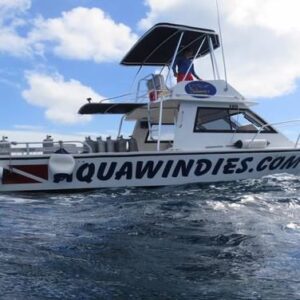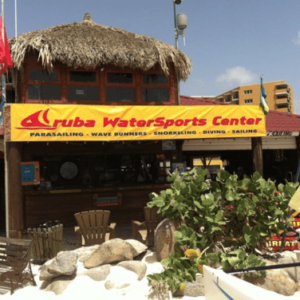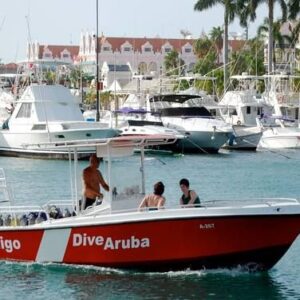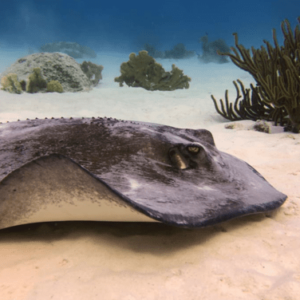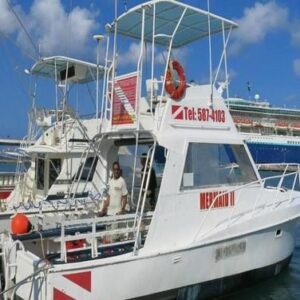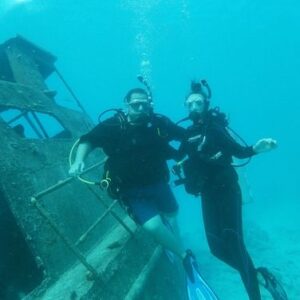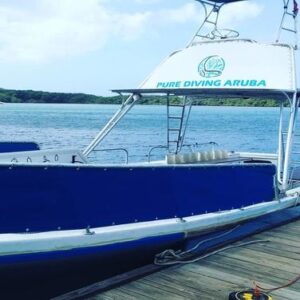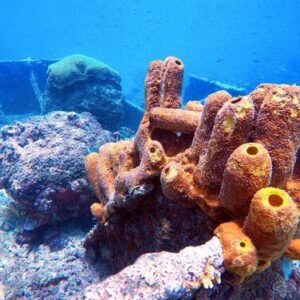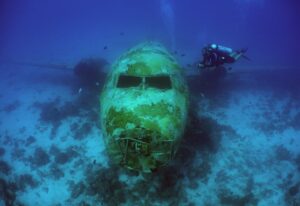Aruba is a tiny Caribbean Dutch Island located eighteen miles north of Venezuela. The island is known for eleven wrecks and twenty dive sites which offer divers some of the best experiences in different and unique settings. Aruba’s warm and life-filled waters offer beginners and experienced divers unmatched aquatic adventures.
The widest point of this island paradise measures just six miles across. This small island has two very well-defined personalities. The northeast coast is undeveloped and filled with wilderness beauty and due to the stronger currents is better suited for more experienced divers. The southwest coast is calmer and blessed with sunshine, white beaches, and clear, turquoise tropical waters and ideal for novice and less experienced divers.
With a wide range of diverse marine habitats, Aruba offers divers experiences from coral reef systems and seagrass fields to mangroves and artificial reefs. Divers have opportunities to witness some of the Caribbean’s most famous shipwrecks, beautiful reefs, and amazing, exotic marine life encounters.
GETTING THERE
Aruba is just over 2-hours flying time from Florida and requires a valid passport.
GETTING AROUND
The roads in Aruba are safe and modern. Vehicles can be rented from Queens Beatrix International Airport. Taxis and public transportation are easy to use and find. The scuba dive sites around Aruba are close to shore, and diving is done from resorts and shore-based centers.
GOOD TO KNOW
Country: Kingdom of the Netherlands
Time Zone: Atlantic Standard Time (GMT-4)
Primary Language: Dutch and Papiamento are the official languages, although English and Spanish are widely spoken.
Currency: Aruban Florin (AWG) however, US Dollars is also widely accepted.
Cell Phone Service: 3G and 4G Cellular networks. Prepaid SIM cards offer you the benefits of using your own phone at local rates.
Voltage: 127V
Hurricane Details: September and October are hurricane seasons but are usually mild because the island lies on the southern edge of the hurricane belt.
DIVE CONDITIONS
Water Temperature: The water in Aruba is very warm with an average of 85 degrees F (29 C) year-round.
Water Visibility: 68-100ft. (20-30m) Aruba’s water is noticeably clear throughout much of the year.
When to Go: Conditions both subsurface and topside are consistently perfect throughout the year, with April to June enjoying the calmest conditions.
Diving Difficulty: Suitable for all levels, including snorkeling.
TOP DIVE SITES IN ARUBA
Aruba caters to the diving enthusiast! Listed are some of the very best that Aruba can offer divers:
- The WWII German Freighter Antilla is the largest and one of the best wrecks in the Caribbean known as the Ghost Ship. It is considered a great dive for both snorkelers and scuba divers. This dive is good for both day and night diving. As Aruba’s signature wreck dive, the Antilla, was a WWII German freighter, intentionally destroyed in 1940. The wreckage is situated 10 minutes from shore and lies on its port side in 45ft of water. Antilla is adorned in large corals and tube sponges. Dives include swimming through the large cargo holds which are also home to dozens of schools of tropical fish.
- The Jane Sea is a smaller Venezuela cement freighter that was sunk in 1988. Myth says the ship sank after authorities found cocaine on board. It is about 250 feet long and is one of the most spectacular wrecks in Aruba. Good for day and nighttime dives, it is best for advanced divers due to the deep water and strong currents. Large schools of angelfish, barracuda, and the occasional manta ray can be seen while enjoying The Jane Sea.
- The Pedernales was an oil tanker damaged in WWII when a torpedo divided it into three sections in 1942 in only 33ft of water. The US military salvaged the bow and stern. The middle section remains in the waters and is a popular dive site. This wreck is fantastic for novice divers and snorkelers. Toilets and basins can be seen when exploring sections of cabins which are now home to grouper, moray eels, and other dark-loving creatures. Novice photographers enjoy the outside of the wreck. It provides an artificial reef to schools of damselfish and angelfish.
- Finger Reef is a relatively deep natural reef site along the southern coast where vigorous currents foster huge finger-shaped coral formations. This patchwork of colorful soft corals is home to numerous turtles and abundant schools of small fish.
- DC-3 and YS-11 Airplane Wrecks were sunk to create an artificial reef to give Aruba scuba divers an exceptional diving experience with impressive photo opportunities. This deliberately created artificial reef is a unique site full of diverse marine life and lush coral polyps. Batfish, angelfish, eels, and many other crustaceans have made their home among the unusual wreckage.
- Mas Bango Reef: is a colorful sloping reef of effervescent hard and soft coral that is located close to Finger Reef surrounded by soft sand. The reef begins at only 5ft and at its maximum depth of 130ft, divers will experience coral islands circled by shoals of Mas Bango fish which attract predators such as tuna, and barracuda.
- Debbie 11 is a 120 feet long fuel barge that was intentionally sunk in 1992 to create a new dive site. This site offers good photo opportunities.
- Star Garret is a cargo shipwreck wreck measuring three hundred feet long. This wreck is home to plenty of marine life that makes for a thrilling dive.
- Tugboat measures 20 feet and continues to 70 feet where a diver can see Moray eels, stingrays and octopuses.
REEF DIVES IN ARUBA
Beginner Diving Reefs
- Arashi Reef
- Baby Beach Reef
- Dantchi’s Delight Reef
- Harbor Reef
- Mas Bango Reef
Advanced Diving Reefs
- Bali Barge Reef
- Cabez Reef
- Kantil Reef
- Mas Bango Reef
Photo Op Reefs
- Barcadera Reef
- Mike’s Reef
- Planco Reef
- Mas Bango Reef
- Kantil Reef
- Shark Reef
- Skalahein Reef
Scuba diving in Aruba is an exceptional diving location for beginners and a perfect place to be certified. An Aruba scuba diving vacation is an excellent choice for divers who are scuba enthusiasts and expect an electrifying dive in numerous different and unforgettable sites.


